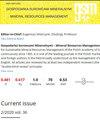西南山区浅埋煤层地裂缝综合治理技术:典型案例研究
IF 0.8
4区 工程技术
Q4 MINERALOGY
Gospodarka Surowcami Mineralnymi-Mineral Resources Management
Pub Date : 2023-07-20
DOI:10.24425/118641
引用次数: 7
摘要
本文是为了环境保护和科学开采浅层煤层而对地裂缝进行治理的成果。在中国西南矿区,传统的长壁开采方法造成了大面积地表塌陷、地裂缝、植被退化、煤矸石无序等问题。针对这些问题,提出了地裂缝处理技术与地下回填技术相结合的综合治理技术。详细阐述了工艺原理和工艺流程;地裂缝处理技术采用“三步处理法”,地下回填技术采用条带开采法配合回填技术。研究了煤矸石、粉煤灰、普通硅酸盐水泥等回填材料的压缩力学行为;选择混合比例为1:0.3:0.18。此外,通过FLAC3D数值模拟确定了煤柱的垂向应力、垂向位移和塑性区,由于煤柱垂向应力较低、垂向位移较小、支护能力较好,确定了“采宽11 m、煤柱宽2 m”的合理开采方案。地面塌陷监测结果表明,地面塌陷最大变形量为17.3 cm,该技术实施后变形量变化不大。煤矸石和粉煤灰处理能力达到821.150 t /年,地裂缝处理区内植被成活率达到85%。该综合治理技术可以有效控制地裂缝和地表塌陷,保护环境。本文章由计算机程序翻译,如有差异,请以英文原文为准。
An integrated treatment technology for ground fissures of shallow coal seam mining in the mountainous area of southwestern China: a typical case study
This article is the result of treatments on ground fissures for environmental protection and scientific shallow coal seam mining. In the southwestern mining area of China, the traditional longwall mining method has caused a large area of surface sinkhole, ground fissures, vegetation deterioration and disorderly coal gangue. To solve these problems, an integrated treatment technology that includes ground fissure treatment technology and underground backfilled technology was proposed as a solution. The technical principle and technical process were explained in detail; the ground fissure treatment technology involves a “three-step treatment method”, and the underground backfilled technology adopted a strip mining method with backfilling technology. The compression mechanical behavior of backfilled material, including coal gangue, fly ash and ordinary Portland cement, was studied; the mixed ratio of 1:0.3:0.18 was selected. In addition, the vertical stress, vertical displacement and plastic zone of the coal pillar were determined by FLAC3D numerical simulation, and a rational mining scheme of “11 m mining width, 2 m coal pillar width” was determined to be appropriate because of the lower vertical stress, smaller vertical displacement and better supporting capacity of the coal pillar. The monitoring results of ground sinkhole indicated that the maximal ground sinkhole deformation was 17.3 cm, and the deformation showed few changes after this technology was implemented. The treatment capacity of coal gangue and fly ash reached 821.150 t per year, and the vegetation survival rate of the ground fissure treatment area reached 85%. This integrated treatment technology could effectively control ground fissures and surface sinkhole as well as protect the environment.
求助全文
通过发布文献求助,成功后即可免费获取论文全文。
去求助
来源期刊
CiteScore
1.80
自引率
11.10%
发文量
0
审稿时长
>12 weeks
期刊介绍:
Gospodarka Surowcami Mineralnymi – Mineral Resources Management is a journal of the MEERI PAS and the Committee for Sustainable Mineral Resources Management of the Polish Academy of Sciences. The journal has been published continuously since 1985. It is one of the leading journals in the Polish market, publishing original scientific papers by Polish and foreign authors in the field broadly understood as the management of mineral resources. Articles are published in English. All articles are reviewed by at least two independent reviewers (the Editorial Board selects articles according to the “double-blind review” principle).

 求助内容:
求助内容: 应助结果提醒方式:
应助结果提醒方式:


